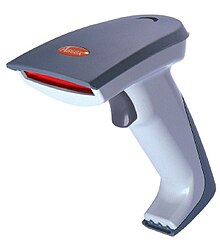Bar code medication administration

Bar code medication administration (BCMA) is a barcode system designed by Glenna Sue Kinnick to prevent medication errors in healthcare settings and to improve the quality and safety of medication administration. The overall goals of BCMA are to improve accuracy, prevent errors, and generate online records of medication administration.
History
BCMA was first implemented in 1995[1] at the Colmery-O'Neil Veteran Medical Center in Topeka, Kansas, US. It was created by a nurse who was inspired by a car rental service using bar code technology. From 1999 to 2001, the Department of Veterans Affairs promoted the system to 161 facilities.[2] Cummings and others recommend the BCMA system for its reduction of errors. They suggest healthcare settings to consider the system first while they are waiting for radiofrequency identification (RFID). They also pointed out that adopting the system takes a careful plan and a deep change in work patterns.[3] As of the year 2004, hospitals were mandated by the federal government to start using BCMA for all prescription drugs.[4]
Implementation

It consists of a bar code reader, a portable or desktop computer with wireless connection, a computer server, and some software. When a nurse gives medication to a patient in a healthcare setting, the nurse can scan the barcode on the patient's wristband on the patient to verify the patient's identity. The nurse can then scan the bar code on medication and use software to verify that he/she is administering the right medication to the right patient at the right dose, through the right route, and at the right time ("five rights of medication administration").[5] Bar code medication administration was designed as an additional check to aid the nurse in administering medications; however, it cannot replace the expertise and professional judgment of the nurse. The implementation of BCMA has shown a decrease in medication administration errors in the healthcare setting.[6]
Bar codes on medication have federal government guidelines that are reflected within the bar code packaging.[7] The first few digits are used to identify the labeler, this code is issued by the Food and Drug Administration. The next section of the label contains the product code, known as the medication, and the last section of the bar code label lists the packager's code for the medication.[8]
See also
References
- ^ Wideman MV, Whittler ME, Anderson TM (February 2005). "Barcode medication administration: Lessons learned from an intensive care unit implementation". In Henriksen K, Battles JB, Marks ES, Lewin DI (eds.). Implementation Issues. Advances in Patient Safety: From Research to Implementation. Vol. 3. Rockville, MD: Agency for Healthcare Research and Quality. pp. 437–51. PMID 21249984 – via NCBI Bookshelf.
- ^ Coyle GA, Heinen M (January 2005). "Evolution of BCMA Within the Department of Veterans Affairs". Nursing Administration Quarterly. 29 (1): 32–8. doi:10.1097/00006216-200501000-00007. PMID 15779703.
- ^ Cummings J, Bush P, Smith D, Matuszewski K (15 December 2005). "Bar-coding medication administration overview and consensus recommendations". American Journal of Health-System Pharmacy. 62 (24): 2626–9. doi:10.2146/ajhp050222. PMID 16333061.
- ^ Callahan, Elizabeth (June 20, 2008). "FDA Federal Bar Code Requirements for Drugs" (PDF).
- ^ Adams, Michael; Holland, Norman; Urban, Carol (2012–2014). Pharmacology for Nurses: A Pathophysiologic Approach. Washington, DC: Pearson. p. 20. ISBN 978-0-13-302618-4.
- ^ Ching, Joan (2014). Using Lean "Automation with a Human Touch" to Improve Medication Safety: A Step Closer to the "Perfect Dose". Joint Commission On Accreditation of Healthcare Organizations: Joint Commission Resources, Inc: The Joint Commission on Accreditation of Healthcare. p. 349.
- ^ Steven (2024-01-06). "Barcode Printer Classification and Purchasing Guide". Retrieved 2024-04-22.
- ^ "National Drug Code Directory". U.S. Food and Drug Administration. October 9, 2017. Retrieved September 18, 2017.
Further reading
- Institute for Safe Medication Practices Canada; Canadian Patient Safety Institute. "The Canadian Pharmaceutical Bar Coding Project". The Institute for Safe Medication Practices Canada (ISMP Canada).
